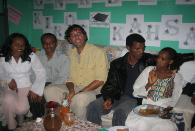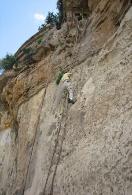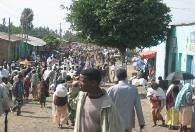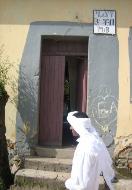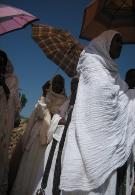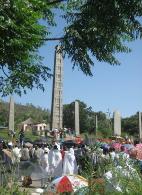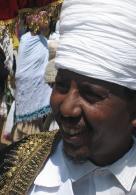Ethiopia update
I approached the man and said in my limited Amharic, “Chigger yellum (No problem). Ishee
(He’s OK).” And then, in an instant my thoughts raced and I began mumbling, “Huh? Oh no.
NO. NO.…No, don’t do that. No, really. Come on that’s not…”
For a few seconds while standing in the dimly lit and rundown recovery room with the ever
present odor of disinfectant I was unable to talk or even think. The father of the child with
the acute abdomen; the gaunt shoeless stranger wearing the shabby faded lime-green shirt
and trousers; a man who looked ancient but who was probably 10 years my junior, with well
worn worry lines carved into his features; the man who had just stared at me with a blank
look; a look that also spoke of hardship, desperation and worry - before I told him that
everything went fine and that his son would be alright; had just gotten on his hands and
knees and literally kissed my boot in an expression of gratitude. Never in my relatively few
years as a surgeon have I ever seen such a display; on one hand it was touching, but it was
also severely unnerving. What do you say? How do you respond? When he once again
stood, I smiled, shook his hand, and slowly shuffled away.
It had been a good day. The health officers that we are training did an outstanding job. After
a number of smaller cases, Kinde and Ephriem had successfully excised a large tumor from
a woman’s leg; and Neguesse did a caesarian section by himself, even dealing with some
problematic bleeding. He then recognized the need to operate on the 10 year old boy and
did a great job in the OR.
So, greetings from the northern Ethiopian town of Axum near the Eritrean border. This time I
am part of a surgical training mission run by Médecins du Monde (MDM-Doctors of the
World). The program aims to train Ethiopian health officers and nurses in emergency
obstetric and surgical care. By the end of the nine month program trainees should be able
to deal with most obstetric emergencies, perform caesarian sections, and handle many
surgical emergencies including appendicitis, incarcerated hernias, and basic trauma care.
Funding is mostly provided by UNFPA: the United Nations Population Fund.
This Emergency Obstetrics and Surgery training program began almost two years ago and
already graduated one class of trainees. Last year seven three-person teams successfully
completed the clinical and theoretical work and are now functioning independently in their
respective health centers and hospitals. This year another seven teams are being trained.
The teams consist of one health officer and two nurses. The training sites are St. Mary
Hospital here in Axum (four teams) and the Mekelle Hospital (three teams) in the district
capital: Mekelle. The health officers learn pre- and post-operative care and how to operate;
one nurse is trained in anesthesia and the other to pass instruments and assist in surgery.
Although there is some controversy surrounding these types of training programs - and
certainly nine months of training can not compare to the rigors of a full surgical residency -
the fact remains that there is a massive shortfall of medical personnel capable of providing
for the surgical needs of the populations in countries like Ethiopia .
As a matter of background, Ethiopia is the second most populous country in Africa (after
Nigeria ), with a population of over 70 million. It is also one of the poorest; annual per capita
GNP is roughly US$ 100 – that almost half of Malawi ’s and one third of Haiti ’s.
I am here until the end of September and function as a surgical trainer. Also for the record,
this is not a substitution program, meaning my priorities are to teach and not to operate.
That also means that many of the larger elective cases will either not be done or must be
referred to another facility. However, we certainly operate on all emergent cases. Aside from
the numerous caesarian sections and appendectomies, there have also been trauma
laparotomies, small and large bowel volvulus, typhoid perforations, colon tumors, and even
a few thyroids. The issue is how to care for the needs of the local population and train the
health officers and nurses.
The St. Mary Hospital in Axum is a 150 bed facility which is lacking in all the modern
conveniences of American and European hospitals. There is, however, running water. As for
electricity, well, city power functions most of the time; however, the hospital’s generator is
currently malfunctioning, so when the power goes out - 3 times last week - it is nice to have
some flashlights on hand. The surgery ward has seven rooms that are functional and fairly
clean: each has six to ten beds. A recovery room with four beds has one nurse anesthetist
trainee covering and there is good recording of vital signs and fluid balances. Relatives can
donate blood for patients; there is usually x-ray capability, although limited at night; and a
functioning lab for measuring hematocrit and even liver function tests. I can’t really complain;
but then again maybe I’m biased.
The town of Axum , although by no means picturesque, is pleasant. The population is
reportedly 50-60,000 and it is estimated that the hospital serves a total populace of 250-
300,000. Unlike many other cities in sub-Saharan Africa , the houses are mostly made of
sandstone and the unpaved side streets and occasional camel give it a middle-eastern
flavor. There are a few hotels and restaurants, some curio shops, and a lively Saturday
market. As the former capital of the Axumite Empire which lasted from the 1st to the 7th
century AD, Axum is a major tourist destination. Aside from also being the reputed home of
the Queen of Sheba, local legend states that the Ark of the Covenant is kept at the Mary of
Zion Church. As only the official guardian is allowed to enter – No, I haven’t seen it.
As for the country in general, if you imagine that Ethiopia is only a barren wasteland and
famine stricken (possibly a result of the 1985 famine, the subsequent media coverage, and
events such as LiveAid), that is certainly not the case. Although deserts certainly exist,
Ethiopia is predominately in the highlands: the capital Addis Ababa sits at over 2000 meters
(6000 feet), and now that it’s the end of the rainy season, the terraced hills and
mountainous slopes are lush and green.
Unlike other parts of Africa where the staple diet consists of bland porridge, the Ethiopian
diet is based on a locally grown grain called tef. The tef is ground up, fermented for 3 days,
and becomes a huge spongy foamy pancake-like-bread stuff (injera). Injera is served at
most meals and pieces are torn off and used to scoop up the various meats, vegetables and
stews. The choices are varied, tasty, and occasionally very spicy.
You may have also heard reports of floods throughout the county; I have not experienced
any of it as the flooding occurred further south and east. We are currently at the end of the
rainy season, and although it usually rains for about an hour or so most days, it really has
not been too bad. The temperature has been rather cool in the 50s to upper 60s (10-15 C).
Also for the record, I am nowhere near the fighting and unrest on the Somali border. That is
many miles to the southeast. Axum, although close to the fighting during the war with Eritrea
is stable. Reportedly, however, large numbers of UXO and landmines remain from the
conflict. Luckily I haven’t seen any evidence and have not heard of any recent incidents.
As for work, well, things are going pretty well.
Besides me, the team consists of a local medical coordinator, Dr. Dawit, who overseas the
logistics and the program in general. There is also another expat couple - a French surgeon
and anesthesiologist: Christian and Chantal. They were here for a few months earlier in the
year and are again back for another month. Christian, the surgeon, and I split the nightly
calls which have been rater quite, although on most nights I have had to go in at least once.
On weekdays we begin at 8 a.m. with rounds in the recovery room. It has been very
satisfying to teach the health officers, whom I might add are very intelligent and eager to
learn. Although they have only had three years of health officer school, they are very
knowledgeable with respect to anatomy, physiology and pathology. They require training in
pre and post-operative care and of course need to hone their operative skills.
We do elective operations each morning until about 1 pm; which so far have mostly
consisted of hernias, hydroceles, anal fistulas and hemorrhoids, drainage of abscesses, and
tumor excisions. The health officers are quite proficient in the smaller cases and are rapidly
learning how to operate independently.
Each afternoon there is an OPD (outpatient department) clinic where one of the health
officers sees cases with either Christian or me. Post-op patients are reviewed, new patients
are seen, and elective operations are scheduled. Emergencies come at any time. The four
house officers, Ephriem, Kinde, Negusse, and Girma rotate weekly and are divided into
covering: operating theatre 1, operating theatre 2, the surgery ward, and maternity. A health
officer covers each night and they are on duty once every fourth day.
After the OPD, usually around 4 or 5 pm there are lectures. Chantal, the anesthesiologist
has been teaching the nurse anesthetist students, and Christian and I have been giving
lectures to the health officers. Christians has been covering orthopedic trauma and
fractures, and I have been covering basic trauma care and war surgery, and of course I
showed Robin Coupland’s management of landmine injuries video.
So those are some of the basics for the moment. I will try to send another update out next
week; until then all I will say is chigger yellum - no problem.
Cheers and best to all,
I approached the man and said in my limited Amharic, “Chigger yellum (No problem). Ishee
(He’s OK).” And then, in an instant my thoughts raced and I began mumbling, “Huh? Oh no.
NO. NO.…No, don’t do that. No, really. Come on that’s not…”
For a few seconds while standing in the dimly lit and rundown recovery room with the ever
present odor of disinfectant I was unable to talk or even think. The father of the child with
the acute abdomen; the gaunt shoeless stranger wearing the shabby faded lime-green shirt
and trousers; a man who looked ancient but who was probably 10 years my junior, with well
worn worry lines carved into his features; the man who had just stared at me with a blank
look; a look that also spoke of hardship, desperation and worry - before I told him that
everything went fine and that his son would be alright; had just gotten on his hands and
knees and literally kissed my boot in an expression of gratitude. Never in my relatively few
years as a surgeon have I ever seen such a display; on one hand it was touching, but it was
also severely unnerving. What do you say? How do you respond? When he once again
stood, I smiled, shook his hand, and slowly shuffled away.
It had been a good day. The health officers that we are training did an outstanding job. After
a number of smaller cases, Kinde and Ephriem had successfully excised a large tumor from
a woman’s leg; and Neguesse did a caesarian section by himself, even dealing with some
problematic bleeding. He then recognized the need to operate on the 10 year old boy and
did a great job in the OR.
So, greetings from the northern Ethiopian town of Axum near the Eritrean border. This time I
am part of a surgical training mission run by Médecins du Monde (MDM-Doctors of the
World). The program aims to train Ethiopian health officers and nurses in emergency
obstetric and surgical care. By the end of the nine month program trainees should be able
to deal with most obstetric emergencies, perform caesarian sections, and handle many
surgical emergencies including appendicitis, incarcerated hernias, and basic trauma care.
Funding is mostly provided by UNFPA: the United Nations Population Fund.
This Emergency Obstetrics and Surgery training program began almost two years ago and
already graduated one class of trainees. Last year seven three-person teams successfully
completed the clinical and theoretical work and are now functioning independently in their
respective health centers and hospitals. This year another seven teams are being trained.
The teams consist of one health officer and two nurses. The training sites are St. Mary
Hospital here in Axum (four teams) and the Mekelle Hospital (three teams) in the district
capital: Mekelle. The health officers learn pre- and post-operative care and how to operate;
one nurse is trained in anesthesia and the other to pass instruments and assist in surgery.
Although there is some controversy surrounding these types of training programs - and
certainly nine months of training can not compare to the rigors of a full surgical residency -
the fact remains that there is a massive shortfall of medical personnel capable of providing
for the surgical needs of the populations in countries like Ethiopia .
As a matter of background, Ethiopia is the second most populous country in Africa (after
Nigeria ), with a population of over 70 million. It is also one of the poorest; annual per capita
GNP is roughly US$ 100 – that almost half of Malawi ’s and one third of Haiti ’s.
I am here until the end of September and function as a surgical trainer. Also for the record,
this is not a substitution program, meaning my priorities are to teach and not to operate.
That also means that many of the larger elective cases will either not be done or must be
referred to another facility. However, we certainly operate on all emergent cases. Aside from
the numerous caesarian sections and appendectomies, there have also been trauma
laparotomies, small and large bowel volvulus, typhoid perforations, colon tumors, and even
a few thyroids. The issue is how to care for the needs of the local population and train the
health officers and nurses.
The St. Mary Hospital in Axum is a 150 bed facility which is lacking in all the modern
conveniences of American and European hospitals. There is, however, running water. As for
electricity, well, city power functions most of the time; however, the hospital’s generator is
currently malfunctioning, so when the power goes out - 3 times last week - it is nice to have
some flashlights on hand. The surgery ward has seven rooms that are functional and fairly
clean: each has six to ten beds. A recovery room with four beds has one nurse anesthetist
trainee covering and there is good recording of vital signs and fluid balances. Relatives can
donate blood for patients; there is usually x-ray capability, although limited at night; and a
functioning lab for measuring hematocrit and even liver function tests. I can’t really complain;
but then again maybe I’m biased.
The town of Axum , although by no means picturesque, is pleasant. The population is
reportedly 50-60,000 and it is estimated that the hospital serves a total populace of 250-
300,000. Unlike many other cities in sub-Saharan Africa , the houses are mostly made of
sandstone and the unpaved side streets and occasional camel give it a middle-eastern
flavor. There are a few hotels and restaurants, some curio shops, and a lively Saturday
market. As the former capital of the Axumite Empire which lasted from the 1st to the 7th
century AD, Axum is a major tourist destination. Aside from also being the reputed home of
the Queen of Sheba, local legend states that the Ark of the Covenant is kept at the Mary of
Zion Church. As only the official guardian is allowed to enter – No, I haven’t seen it.
As for the country in general, if you imagine that Ethiopia is only a barren wasteland and
famine stricken (possibly a result of the 1985 famine, the subsequent media coverage, and
events such as LiveAid), that is certainly not the case. Although deserts certainly exist,
Ethiopia is predominately in the highlands: the capital Addis Ababa sits at over 2000 meters
(6000 feet), and now that it’s the end of the rainy season, the terraced hills and
mountainous slopes are lush and green.
Unlike other parts of Africa where the staple diet consists of bland porridge, the Ethiopian
diet is based on a locally grown grain called tef. The tef is ground up, fermented for 3 days,
and becomes a huge spongy foamy pancake-like-bread stuff (injera). Injera is served at
most meals and pieces are torn off and used to scoop up the various meats, vegetables and
stews. The choices are varied, tasty, and occasionally very spicy.
You may have also heard reports of floods throughout the county; I have not experienced
any of it as the flooding occurred further south and east. We are currently at the end of the
rainy season, and although it usually rains for about an hour or so most days, it really has
not been too bad. The temperature has been rather cool in the 50s to upper 60s (10-15 C).
Also for the record, I am nowhere near the fighting and unrest on the Somali border. That is
many miles to the southeast. Axum, although close to the fighting during the war with Eritrea
is stable. Reportedly, however, large numbers of UXO and landmines remain from the
conflict. Luckily I haven’t seen any evidence and have not heard of any recent incidents.
As for work, well, things are going pretty well.
Besides me, the team consists of a local medical coordinator, Dr. Dawit, who overseas the
logistics and the program in general. There is also another expat couple - a French surgeon
and anesthesiologist: Christian and Chantal. They were here for a few months earlier in the
year and are again back for another month. Christian, the surgeon, and I split the nightly
calls which have been rater quite, although on most nights I have had to go in at least once.
On weekdays we begin at 8 a.m. with rounds in the recovery room. It has been very
satisfying to teach the health officers, whom I might add are very intelligent and eager to
learn. Although they have only had three years of health officer school, they are very
knowledgeable with respect to anatomy, physiology and pathology. They require training in
pre and post-operative care and of course need to hone their operative skills.
We do elective operations each morning until about 1 pm; which so far have mostly
consisted of hernias, hydroceles, anal fistulas and hemorrhoids, drainage of abscesses, and
tumor excisions. The health officers are quite proficient in the smaller cases and are rapidly
learning how to operate independently.
Each afternoon there is an OPD (outpatient department) clinic where one of the health
officers sees cases with either Christian or me. Post-op patients are reviewed, new patients
are seen, and elective operations are scheduled. Emergencies come at any time. The four
house officers, Ephriem, Kinde, Negusse, and Girma rotate weekly and are divided into
covering: operating theatre 1, operating theatre 2, the surgery ward, and maternity. A health
officer covers each night and they are on duty once every fourth day.
After the OPD, usually around 4 or 5 pm there are lectures. Chantal, the anesthesiologist
has been teaching the nurse anesthetist students, and Christian and I have been giving
lectures to the health officers. Christians has been covering orthopedic trauma and
fractures, and I have been covering basic trauma care and war surgery, and of course I
showed Robin Coupland’s management of landmine injuries video.
So those are some of the basics for the moment. I will try to send another update out next
week; until then all I will say is chigger yellum - no problem.
Cheers and best to all,
